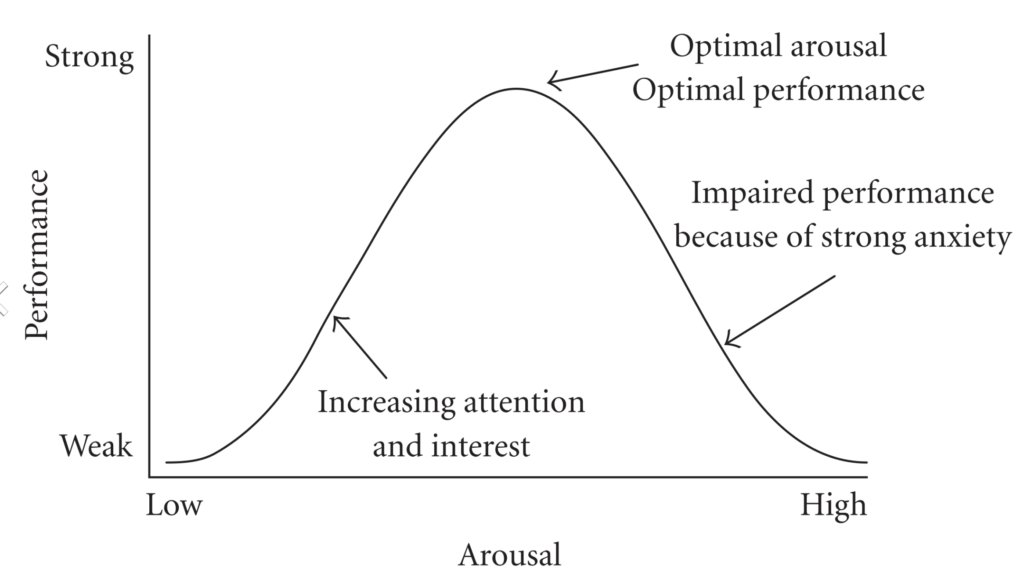
What … There Is An Upside of Anxiety?
Not too long ago, I was pulled into the General Manager’s office of one of the sporting teams that I’ve been working with for the last two years. I was told that my intensity was creating some anxiety for the players, especially before matches. He asked me, “Isn’t a sport psychologist supposed to reduce anxiety rather than increase it?”
My answer was simple … “no”.
What this short conversation made me realise is just what a bad reputation poor old anxiety still has. And how the general appraisal of anxiety is far, far worse than this very normal, common, sometimes helpful human emotion.
The concept that anxiety is bad and that eliminating it or reducing it is good for performance is arguably one of the most damaging myths floating around out there.
A Neurochemical Look At Anxiety
Let’s take a neurochemical look at anxiety first and foremost. Obviously, with full appreciation of individual differences, most people’s experience of anxiety is generally an increase in arousal (not that type 🤦). Not always, but often, this takes place before or during an important event or moment. Due to this, our bodies try to help us by releasing hormones like norepinephrine, adrenaline and dopamine. These hormones are typically very beneficial, but they do often feel unsettling. So, in many ways, anxiety is an umbrella term used to describe some of these many internal sensations:
- Thoughts related to appropriate worrying. “I really hope I don’t stuff up in tomorrow’s final”.
- Bodily Sensations – Feeling nervous, restless or tense. Having an increased heart rate. Breathing rapidly (hyperventilation), sweating, trembling. Having trouble sleeping. Experiencing gastrointestinal (GI) problems (butterflies). Wanting to go to the toilet more than normal (for both numbers ones and number twos).
You will see that I have not listed the word ’emotions’ above, as typically, this refers to an individual’s unique experience. For example, when I am nervous, I tend never to sweat, but for others, this is the very first thing that might happen.
Misinterpretations Galore
Where many people go wrong is that they essentially misinterpret the above internal stimuli. Instead of seeing them as either very normal in the lead-up to something important (or even useful), they see them as a problem. They drastically misread these sensations as being an impediment to optimal performance.
So they don’t just worry; they worry about worrying. Or worse, they panic about the worry. This is called metacognitive worry. Sometimes, it can be useful to break down an individual’s experience of anxiety and just determine whether or not it’s actually possible to perform competently.
For example, lack of sleep. Next time you have a poor night’s sleep, go out and train and see what happens. The scientific evidence on sleep deprivation is incredibly clear now. Individuals would need to experience five or six consecutive nights of very poor sleep before it started to have a dramatic impact on anything that they were highly skilled at. One night of prank calls from the team’s practical joker isn’t going to do much.
Some of these misinterpreted reactions of anxiety are actually very beneficial. Look at how the body generally will increase our need to go to the toilet before an important event. Particularly in sports, it is obviously better if you have “emptied” your bladder and bowels well before the gun goes off. That’s all your body is trying to do. To help you. And yes, the fact that you have to go to the loo more often than normal is just a natural consequence of this.
And an increase in breathing rate …. fairly obvious, right? You get the picture.
Not All Anxiety Is The Same
I want to be absolutely clear here that I’m not suggesting that all forms of anxiety are harmless and/or beneficial. Clearly, there are some situations where the original experiences of nervous energy are so powerful that they genuinely block other homeostatic processes. Such as breathing, for example. However, even in these extreme clinical situations, a portion of the problem is caused by the misjudgement of the original internal stimulus.
But the vast majority of ‘anxiety situations’ that come across our desks as sport and performance psychologists are not these extreme types. It’s the normal kind, the healthy kind. It’s the upside of anxiety because the client is invariably involved in some fairly important stuff. Think Olympic Games and/or performing open heart surgery on a toddler. That kind of stuff.
The Inverted U Hypothesis

A large part of anxiety’s poor reputation can be traced back to a theory that is often called the Inverted U hypothesis. In summary, it suggests that too little or too much anxiety is bad for performance. As per the above graph, an upside U or inverted U. I remember very clearly being taken through this theory during my Masters of Sport and Exercise Psychology at Western Sydney University back in 2004. Back then, I did not question it for a nanosecond. Even worse, it was a significant part of my consulting in the first years of Condor Performance. I organically moved away from using it when I realised that the frameworks related to Psychological Flexibility were far more effective.
But it was only earlier this year, when we had the pleasure of having legendary sport psychologist Jonah Oliver attend our annual Condor Performance Summit, that I realised just how ridiculous this theory was.
You see, the theory is one of the most flimsy ever from a scientific point of view. The Yerkes-Dodson Law’s original formulation derives from a 1908 paper on experiments in Japanese dancing mice learning to discriminate between white and black boxes using electric shocks. This research was largely ignored until the 1950s when Donald O. Hebb’s concept of arousal led to renewed interest in the Yerkes-Dodson law’s general applications in human arousal and performance. But virtually no thorough investigation was ever done to prove that elite human performance depended on some anxiety and suffered from too little or too much. Yet, it was assumed to be true and still is in most circles.
So I Leave You With Some Facts …
- Well-rehearsed gross motor skills are incredibly independent and stable of whatever emotions are being experienced at that time. But as long as these emotions are allowed to exist in their natural state. Anxiety is just one of the many different emotions we experience. In brief, you can perform optimally whilst you are very, very nervous.
- Fine motor skills and/or novice motor skills are more vulnerable to some common byproducts of anxiety (e.g. shaking), but even in these situations, it’s still the misjudgement of the anxiety that is the greater threat to performance.
- Anxiety, as with all emotions and many thoughts, is an outcome. It’s a consequence, a result of something. And therefore, we only have a small amount of influence on it.
- The best way to manage anxiety is to accept it as a normal, healthy part of the human experience. It is even better to see it as an indication that something important is on the horizon. Notice it and commit to the actions/processes of the task at hand.
- Trying to reduce anxiety is an example of experiential avoidance. Below is a great 4-minute video on experiential avoidance that is worth watching.
And As Always, If You Need A Hand …
Then get in touch via one of these methods: ⏩ Email us directly at info@condorperformce.com and let us know more about you and how we can help. ⏩ Fill in one of our four Mental Toughness Questionnaires and tick the box at the end when it asks if you’d like to receive info about our services. We typically respond within 48 hours.

A very interesting read and the part of the article that stood out to me was the misinterpretation of internal stimulus. I get the sense that other facets of brain function play a role in increasing the chance of forming the relationships you mentioned. For example, the way we categorize, combined with our logic and reasoning. We categorize something as bad and then our first point of logic works on how to remove or avoid it. I love the final points, particularly that anxiety is a normal part of the human experience and an indicator that something important is on the horizon.
Thanks Darren …. yes, even vomiting (often considered the worst case scenario of extreme pre-performance nerves) is just not that bad and without too much imagination has the same kind of preparatory benefits as going to the toilet frequently. Basically an “emptying out” of the unnecessary contents of the body.
Gareth – I think that your assertion is correct where the individual has a degree of control over the situation -i.e. they are facing an external stressor that they can control or influence.
However, in team sports (and in life) the level of anxiety is often the result of pressure from an external source (e.g., a team leader exerting huge pressure or purely circumstance) and the individual’s response is very much dependent on their ability to physically respond and their mental resilience. Equally the external influence (team leader) can have a mitigating effect on a player’s stress level.
Hi Doug, many thanks for this comment. You are 100% correct in that the biggest contribution to increased stress and anxiety in team sports will tend to be the head coach. An intense head coach is unlikely to create a relaxed environment. But what my article is trying to clarify is that a relaxed team environment should NOT be considered a requirement for performing well / consistency.
Another interesting article Gareth on how anxiety can actually be helpful for performance. I believe it was Jonah Oliver which said that we often feel anxious about certain things because we care so much about them- which I couldn’t agree with more. I find it helpful to explain to athletes that we can still perform well, even when we feel anxious, and accept anxiety is normal.